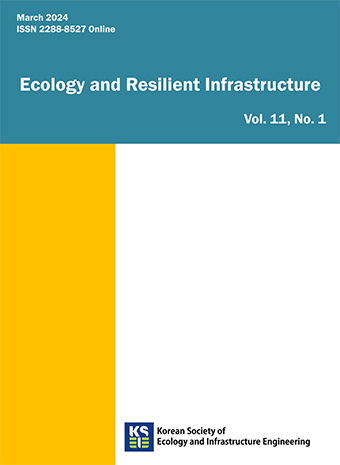Instructions for Authors
Guide for Authors
This Guide is a key reference for any current or prospective author of articles and other content to be published in the journal, “Ecology and Resilient Infrastructure”.
Types of journal content
Contributions to the journal are classified into either: Original Article, Review Article or Short Communications. Original Articles are full-length manuscripts of value and interest to our readers. They should report results of thought-provoking and origina studies. A Review Article is a thought-provoking opinion piece or essay founded in fact, sometimes containing speculation, on topics of general interest and relevance to the readership of the journal. Short Communications describe a method, application or case study that illustrates a new or existing principle or presents an innovative way to solve a problem. Original Articles, and Short Communications can be submitted any time. Review Articles are invited by the Editorial Board or need approvals of the Board before the submission. Manuscripts are submitted to the Editorial office via the online submission system (http://www.jeri.or.kr) or by e-mail (kseie2013@gmail.com)
Authors
At least 50 % of the authors should be full members of the Korean Society of Ecology and Infrastructure Engineering.
Length of manuscript
In principle, the Original Article and Review Article should not exceed 10 printed pages (about 10,000 words). The Short Communications are limited to 5 pages (about 5,000 words). For manuscripts exceeding the allowed length, the approval of the Editorial Board is needed and the authors should bear the type-setting costs for the additional pages.
Manuscript formatting
The manuscript should be written in English or Korean. The preferred software is MS Word. If you have prepared your paper using other systems, you are requested to convert to PDF format and send the PDF only at submission.
Structure of manuscript
Article sections should appear in the following order:
1) Title
2) Authors (affiliation)
3) Abstract
4) Main text sections (Introduction, theory, conclusion, etc.)
5) Acknowledgments (optional)
6) References
7) Notation list (optional)
8) Appendix (optional)
Title
Authors should take care to ensure that the title is specific and accurately reflects the final, post–peer reviewed version of the paper. Each word should start capital letters except articles, prepositions and conjunctions.
e.g.)
Fatigue Behavior and Probabilistic Fatigue Analysis of Concrete Offshore Structures
Name(s) of author(s)
The affiliation(s) including zip code(s) should be provided. The corresponding author’s e-mail address should be provided.
e.g.)
Joon Heo1 and Gil Dong Hong2*
1 Department of Civil Engineering, Seoul National University, Seoul 08826, Korea
2 Department of Civil Engineering, Hankuk University, Seoul 08826, Korea
* Corresponding author: kjournal@ksce.or.kr, ORCID 0000-0001-8041-6230
Symbols and terms
It is recommended that symbols and terms be used in conventional ways with conventional meanings. Symbols should be defined when they appear first.
Units
Use of SI unit system is required. The negative exponent is preferred to a solidus ‘/’ in the units. It is recommended to put a space between the numeric and the unit except %, ℃, ° and ′.
e.g.)
10 m, 10 m-1 (or 10/m, acceptable), 10 m s-1 (or m/s, acceptable),
10 g m-2 s-1 (but g/m2/s, unacceptable), 10%, 10℃, 10°
Abstract and keywords
The abstract should be written in about 250 words or less in one complete paragraph, including brief outlines and major conclusions on the contents of the article. It should not include any quotes on tables, numerical formulae, or references. Please provide 4~6 keywords which can be used for indexing purposes. Keywords are alphabetized and separated by commas.
e.g.)
KEYWORDS: Civil engineering, Ecology, Infrastructure, Korea
Structure of main text
The main text consists of introduction, methods (or materials and methods, etc.), results, discussion (or results and discussion), conclusions, (acknowledgement), references, (appendix) and so on. In introduction, it is expected that authors include the background and motivations of their work, the current status of related works, the scope of their work, and so on. In the body section (methods, materials, etc.), authors can detail basic theories, assumptions. The theoretical and experimental analysis can appear along with reviews and comparisons of previous work. At the end of the manuscript, authors are expected to include a set of conclusions, or summary and conclusion, in which the significant implications of the information presented in the body of the text are reviewed. Authors are encouraged to explicitly state in the conclusions how their work contributes to the overall body of knowledge for the profession. Each section can have sub-titles with sub-numbers.
e.g.)
1. Introduction
2. Methods
2.1 Study sites
2.2 Field investigation
3. Results
3.1 Characteristics of river bed
3.1.1 Soil types
4. Discussion
4.1 Relationships between vegetation and river bed characteristics
5. Conclusions
Figures and tables
Authors should write numbers and titles under figures. Figures and pictures should appear in separate pages. Since the width of a figure would be less than 7 cm in a printed paper, authors should take care that the characters, symbols and lines are clearly discernable. Tables should appear in separate pages. Table numbers and titles should be written in the upper portion of the tables.
Titles of figures and tables
The format of titles of figures and tables follows the following examples. If two or more figures are listed under the same title, sub-titles with ‘(a), (b), etc.’ can be assigned to each figure. All displayed figures and titles should be numbered sequentially throughout the entire manuscript, including Appendixes.
e.g.)
Fig. 1. Schematic flow diagram.
Fig. 1. Schematic flow diagram. (a) water, (b) soil.
Table 1. Summary of resilient modulus test results
The in-text reference to figures and tables is made as follows.
e.g.)
Fig. 2, Fig. 3 (a), Table 5,
Figs. 3 and 4, Tables 3 (a) and 3 (b), Eq. 2, Eqs. 1 and 2
Equations
Equations are not written along with the sentences. All the symbols used in equations should be indicated in a separate line, and in italics. Even symbols used in the text should also be in italics. All displayed equations should be numbered at the right end, sequentially throughout the entire manuscript, including Appendixes. Equations should be in the body of a manuscript.
e.g.)
f = ma (Eq. 1)
In-text citations
The journal uses the author-date method for in-text references, whereby the source reads as the last names of the authors, then the year.
e.g.)
The results of Zoch (1934) is used in many hydrological models(McCarthy 1938, Clark and Nash 1945, Wood et al. 1959a). Researches by Kim and Cho (2011) and Park et al. (2014) are in progress.
Acknowledgements
Authors may include an Acknowledgments section to recognize any advisory or financial help received. This section should appear after the Conclusions and before the references.
References
References cited in text that are not found in the reference list will be deleted or queried by the Editorial Office. Likewise, all references included in the References section must be cited in the text. All references should be written in English. A References section must be included that lists all references alphabetically by last name of the first author. For references with the same last name of the first author, the last name of the next author is used in the alphabetical order and, then, the published year or the title is used. The name of journals should be written in full name, not abbreviation. For references written in languages other than English, the listing should be finished with the language used in parentheses, e.g., (in Korean), (in Japanese), (in German), (in French).
e.g.)
Papers
Rahuel, J.L. 1993. Modeling of river bed evolution for bedload sediment mixtures. Ecological Engineering 11: 151-160.
Rahuel, J.L. and Holly, F.M. 1993. Modeling of river bed evolution for bedload sediment mixtures. Ecological Engineering 11(2): 151-160.
Rahuel, J.L., Holly, F.M., and Chollet, J.P. 1993. Modeling of river bed evolution for bedload sediment mixtures. Journal of Hydraulic Engineering, ASCE 115: 1521-1542.
Books
Kim, C.G. and Aoe, A. 1996. Ecological Engineering. McGraw-Hill Book Co., Seoul, Korea. (in Korean)
Cho, S.K. 1966. Community structure and function of Korean streams. In, Kim, A.B. (ed.), The Streams in Korea. Hanyang Press, Incheon, Korea. pp. 1-30. (in Korean)
Blong, R.J. 1985. Gully sidewall development in New South Wales Australia. In, El-Swanify, J., Moldenhauer, S.A. and Lo, A. (eds.), Soil Erosion and Conservation. Soil Conservation Society, Ankeny, lowa, USA. pp. 574-584.
Webster, W.C. and Trudell, R.W. 1981. Statistics of local motions on a ship. In, Proceeding of Conference on Directional Spectral Applications. Prentice-Hall, Eaglewood Cliffs, N.J., USA. pp. 461-482.
Websites
Frisch, M. 2007. A low-entropy constraint from influencing the past. http://philsci-archive.pitt.edu/archive/00003390. Accessed 26 June 2009.


 Ecology and Resilient Infrastructure
Ecology and Resilient Infrastructure







